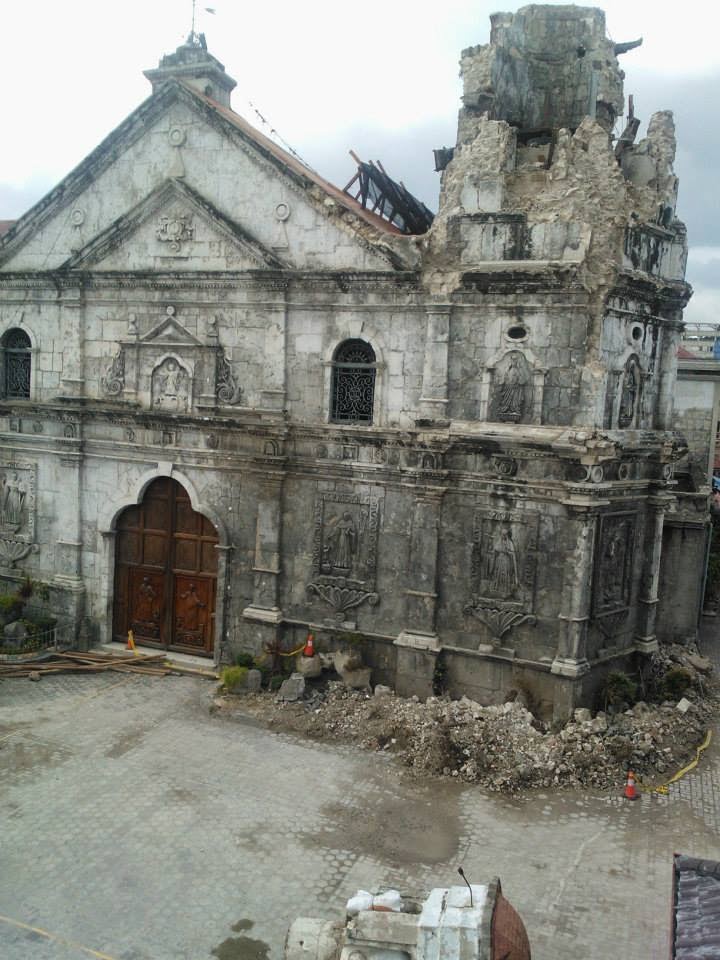As the days went by, photos of the earthquake's extensive damage surfaced in the news, showing damaged houses, impassable roads and bridges that were lined by cracks, inoperable hospitals and government offices, and worst of all, fallen centuries-old churches.
When the opportunity to help came at work, I did not hesitate to leave the comforts of Manila and take risks as the prevailing news at that time prompted most people to expect the worst. (This was around two weeks before the Yolanda disaster.)
Arriving in Cebu on October 25, 10 days after the earthquake, my colleagues and I were greeted by some aftershocks---all of them I did not feel. Cebu seemed quick to recover. The half-hour ride from the Mactan airport to the Metrobank Fuente Osmeña Circle did not show any damage or signs of the earthquake affecting Cebuano's lives. It was, in fact, business as usual in Metro Cebu.
Bohol, however, was a different case.
 |
| Gaping cracks on the road from the Tubigon port |
Miles and miles of damaged properties caught my sight as the bus drove from Tubigon to Clarin. I could not help myself from thinking about someone who I had not seen for quite sometime then. Despite all the issues that we could not settle, there was one thing that held us together even until that time. It was our passion for development work. Peering through the lens of my company-issued camera reminded me of how his photos looked after his community trips. It was as if I was looking at the community through his eyes.
 |
| A house with collapsed walls and ceilings |
Shortly before reaching St. Michael Parish, the site of our relief distribution, a question crossed my mind:
Why does God allow bad things to happen to mankind?
I was seated in the pilgrim center within the courtyard of the Basilica Minore Del Sto. Niño in Cebu City a day later when an answer came.
 |
| Facade of the Basilica Minore Del Santo Niño, the oldest church in the Philippines |
God allows destruction so we may experience rebirth and so we may rebuild---back and hopefully, better.
I thought about Sodom and Gomorrah, the great ancient civilizations that were wiped out by either natural or man-made disasters, and nations that were once called as global super powers. Then I thought about relationships.
When all things just cannot seem to fall into place no matter how hard we try, we need a metaphysical collapse. From chaos, we need a momentary silence so God may work in ourselves. What feels like weeks, months or years for us is only a blink in the eye of God; a fraction of a second in the cosmos.
As the months went by, my reflections were enriched through several spiritual activities, which included some of my mindful walking, chi running and yoga practices, Monday fellowships and Ignatian prayer and share sessions, and recollections.
Yesterday, Fr. Mon Bautista, SJ shared a fitting theme in his Maundy Thursday recollection at Ateneo Rockwell, which has finally given a most proper push to my pen. He shared that spiritual conversion begins with a crisis, "a jolting, jarring experience," which can come in three ways: a sense of dissatisfaction, an experience of pain and sorrow, and a challenge of our faith.
"For you are dust, and to dust you shall return." (Genesis 3:19)
God allows bad things to happen -- our crises -- so we may be humbled; so that we may remember.
Fr. Mon further explains that conversion entails letting go (of possessions, beliefs and habits) that once held us. And once we have let go, we embrace new ways of thinking, perceiving and beholding, which respectively translate to new ways of living, witnessing and loving.
And today, Good Friday, I think about God's only son, Jesus Christ, who He allowed to die on the cross not only for our sins, but to show us that in His resurrection, we may be reborn. In Christ's ministry, He spoke of tearing down the temple, which He will rebuild in three days.
Jesus answered them, "Destroy this temple, and I will raise it again in three days." (John 2:19)
For whatever Christ's statements intend to symbolize, I feel a glimmer of hope today as Pope Francis institutes changes in the way the Catholic Church responds to the issues that have been knocking on its doors for quite some time already.
It is humbling to finally find the courage and the patience to organize my reflections in the form of a blog post. It is, in fact, God's way of helping me remember the reason why I came back.
No comments:
Post a Comment